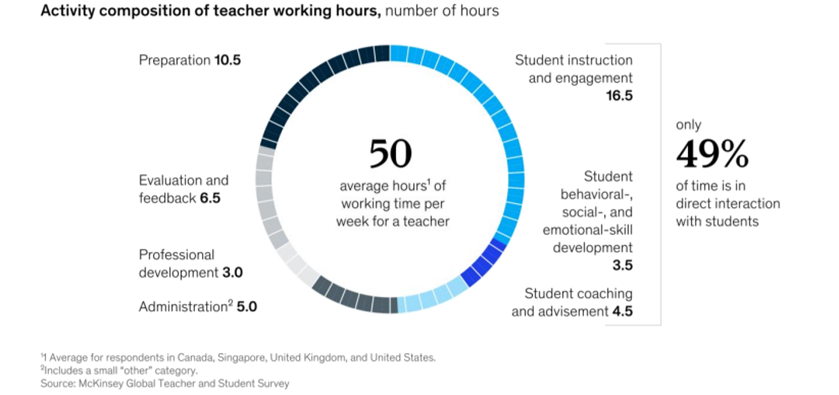How tools like Chat GPT are changing the landscape and how you can take advantage
Artificial Intelligence (AI) continues to revolutionize various aspects of our lives, and one area where its influence is becoming increasingly apparent is public education. Chat GPT, an advanced AI language model, holds immense potential to shape the future of education by offering new opportunities for students, teachers, and administrators. In this article, we will explore the transformative impact of AI on public schools and how it can enhance teaching and learning experiences.
Chat GPT wrote that entire first paragraph.
By now, you’ve recognized the power, and concern of AI tools, like Chat GPT, in education. While it’s crucial to ensure students are not turning in work written by a BOT, it’s just as crucial to recognize how technology is changing the teaching and learning landscape, and use that change to your advantage.
While AI in education is continuing to change, the research already completed shows the best use of AI is when humans are at the center of the technology following these sample concepts for usage: 1) AI assists to reduce routine teaching burdens, 2) AI that helps teachers reflect, plan, support 3) AI helps improve the teaching and learning practice. Among the goals of integrating more AI into education is to ensure that teacher working hours are spent mostly with their students. Currently, according to a recent global teacher and student survey, more time is spent without students than with them, with some saying AI could help flip the script.
Teachers work about 50 hours a week, spending less than half the time in direct interaction with students.

A report by McKinsey Global Teacher and Student Survey first suggested that AI’s initial benefit could be to improve teaching jobs by reducing low-level burdens in administrative or clerical work. The report also suggests that recovered time from AI-enabled technology should be rededicated toward more effective instruction—particularly, outcomes such as reducing the average 11 hours of weekly preparation down to only six.
“One opportunity I see with AI is being able to reduce the amount of attention I have to give to administrative things and increase the amount of attention I can give to my students with their learning needs in the classroom. So that’s the one that I’d say that I’m super excited about the possibility of AI to support me as a teacher.”-Vidula Plante, teacher.
While AI language models like Chat GPT are exciting in how they can help support and engage both students and educators, it is important to critically examine their potential negative impact on public schools. Overreliance on technology, diminished personal interactions, limitations in contextual understanding, data privacy concerns, and the exacerbation of the digital divide, are all important factors to consider.
While tools like Chat GPT can provide answers and explanations, they may also hinder students’ critical thinking and problem-solving skills. Over reliance on AI models for information retrieval can limit the development of analytical reasoning, creativity, and independent thought. Research shows it is essential to strike a balance between leveraging AI tools and fostering students’ cognitive abilities through active learning and collaborative problem-solving, with human interaction at the center of the lesson.
Another important concern to be aware of before embracing AI tools is the inherent bias that can come with each product. AI models like ChatGPT may not be exposed to a diverse range of perspectives which can result in the model having a limited understanding of various cultures, worldviews, and experiences. This can, in turn, impact the quality and inclusivity of the content the AI forum presents. Additionally, AI tools can inadvertently perpetuate existing biases in education materials and assessments and can also reinforce these biases when generating responses or answers. which can impact the quality and inclusivity of educational content. Educators must remember AI tools are not humans and don’t have the capability to be culturally sensitive in their responses and therefore should always be used in a way that takes these factors into account.
Whether you choose to use any AI technologies, educators must understand what is available so you can help support your students who choose to use these new tools. While it is not your responsibility to support the usage of technology that you don’t agree with, it is crucial you understand what your students have access to and may choose to use to support them in their work. No educator wants to see an essay turned in written by Chat GPT, and whether you like it or not, you will have to learn what that type of “fake” essay may look like. For those who choose to embrace some form of AI, it is essential to ensure you’re maintaining human interaction, personalized guidance, and critical thinking skills into each of your lessons-those combined with technology could be a powerful combination in education. Time will tell.
Survey Finds 50% of Educators Require Handwritten Essays
“Some professors fear that students will merely use ChatGPT to create their essays, and neither learn appropriate research and writing conventions nor master the content.”
With the increase of AI, in particular ChatGPT, a research group that helps students make decisions about higher education called Intelligent.com conducted a survey of current high school teachers and college professors. The findings show many educators are changing how they teach to “combat ChatGPT use.”
Amongst the findings:
- 50% of educators are resorting to handwritten assignments,
- 6 in 10 believe ChatGPT can help students learn; many say the tool is a mixed blessing
- More than 1 in 4 say their school has no ChatGPT policy in place
- Older educators are less likely to see the AI tool as a benefit
For those who do not currently require handwritten essays, many are planning on making changes to adapt to the increase in AI technology use among students, ranging from increasing oral presentations to typing assignments in class without wifi available. (see chart)

“Some professors fear that students will merely use ChatGPT to create their essays, and neither learn appropriate research and writing conventions nor master the content,” says Professor and Higher Education Advisor Diane Gayeski. But Gayseki points out, there have always been ways to cheat, it’s just now up to the educator to think of ways to ensure students are incorporating what’s learned in class into their works to create authentic work.
“A student can buy a well-written essay comparing various models of leadership based on important theorists from any number of websites. However, what can’t be bought nor generated by an AI tool is content that specifically relates to material presented in class, such as their textbook, assigned readings, or case studies.
Some information from this article was gathered from U.S. Department of Education, Office of Educational Technology, Artificial Intelligence and Future of Teaching and Learning: Insights and Recommendations, Washington, DC, 2023. This report is available at https://tech.ed.gov

Tools to Consider
With so many AI tools already being used, Maine Educator researched several to help members learn which ones are educator recommended and may help you in your craft. ChatGPT has received the bulk of discussion recently in the AI conversation, but there are many AI tools educators are using to help support their work and their students. When you think about your daily lives, you’re likely already using AI-whether you’re asking Siri or Alexa to be your virtual assistant- AI has a strong presence in how we live and now how we work. Here are some tools to consider as you think about how AI can help support your work.
Goal: I want to support multilingual students and families
Try: ChatGPT
In diverse public school settings where students come from various linguistic backgrounds, ChatGPT can break down language barriers. With its ability to understand and generate text in multiple languages, ChatGPT can assist students in their native languages, fostering inclusivity and ensuring that language proficiency doesn’t hinder learning. This feature not only supports English language learners but also promotes multiculturalism and celebrates linguistic diversity within schools.
Goal: I want to make classroom presentations quicker and more interesting looking
Try: Canva
This ChatGPT alternative has several AI-powered tools within Canva, including Magic Write and Magic Design, that can create templates, content, and images. This AI tool is a time-saver for educators and helpful with prep. Students can also create unique classroom presentations with this tool allowing them to be creative while learning.
Goal: I want to make note-taking more efficient
Try: Dragon Dictation
Dragon Dictation is a voice-to-text AI tool that converts spoken words into written text. Students can use Dragon Dictation to transcribe their thoughts, ideas, or even classroom discussions, making it useful for note-taking or creating written assignments. This tool can also be helpful in a lecture-based setting for note-taking students who simply need to launch the software while you teach, allowing the students to engage in the lecture while the AI takes the notes for them.
Goal: I want to encourage and ignite classroom participation
Try: Parlay Genie
Parlay Genie is a discussion-prompt generator. It crafts higher-order thinking questions for your class based on a topic, a YouTube video, or an article. Use it to spark conversation following a lesson, elevate partner study routines, or generate journal-writing questions.
Goal: I want to help a student after school with math problems, but also want them to practice at home with support
Try: Photomath
Photomath is a mobile application that offers support with math. With Photomath, users can scan printed or handwritten math problems with their smartphone camera, and the app will provide step-by-step solutions in real time. This tool is not to be used for students to solve problems without doing the work, but it is a form of AI that can provide extra specific guidance at home to free up your time to be able to help more students. The goal is to help a student in class or after school with a few problems, then provide them with additional ones to do at home, and in the event they’re struggling they can use this AI tool to learn where they’re making mistakes, understanding the problem-solving process step-by-step.



